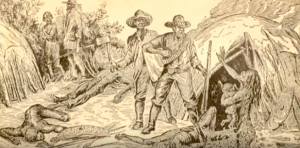By Ruth Kerr
The following tribute was delivered on the occasion of the Ceremony for the 2012 Presentation of the Award of The John Douglas Kerr Medal of Distinction for Historical Research and Writing. It presented by Dr Ruth Kerr, a long-serving member of the Professional Historians Association (Queensland) and life partner of the late John Kerr.
This is a really valuable opportunity to reveal John’s historiography among the history community, most of whom John knew. His gentleness and openness is legendary. His smile is abiding. John’s attention to the primacy of valid sources, to accuracy, his enormous energy and enthusiasm and sense of personal and professional integrity pervaded his whole demeanour. It has been a great privilege for historians and commissioning bodies to work with John.
This year I have selected one of John’s earliest historical articles to speak about – on the investment by William Pettigrew in the first steam locomotive constructed in Queensland for his timber railway in the Tin Can Bay area.
On return to Brisbane in 1968 to work at CSIRO John brought with him a huge database of Queensland railway information compiled from Queensland Parliamentary Papers and newspapers in the State Library of New South Wales.
John began to seek information in a wider range of sources. Queensland State Archives in the newly opened Dutton Park building was John’s next repository to explore. However, sadly there was very little to find there then on railways. The Commissioner for Railways records were transferred to Archives in the mid 1980s when I was working there.
In 1968 information on railways was only to be found in other government agency records – court cases, inquests into accidents, the Arbitration case on Cairns railway construction (Robb case), Governor’s correspondence and land selections.
In 1970John mentioned his great excitement in discovering a photograph in the Governor’s Inwards Correspondence of 1873 of the first steam locomotive built in Queensland at John Walker & Co’s Union Foundry in Maryborough for William Pettigrew.
The source – GOV/A6 p.263 (ID858488) – a letter from William Pettigrew to HE Governor, Hon Marquis of Normanby on 5 August 1873 – became the paramount source material for his research into Pettigrew’s Calooli and Thannae Railway at Tin Can Bay. The accompanying primary sources were the Pettigrew Diaries held by the Royal Historical Society of Queensland then at Newstead House, and the Maryborough Chronicle newspaper held in the newspaper office in Maryborough.
Together with a railway friend, David Bailey, John visited Maryborough Chronicle office on many weekends to gather locally published information on the construction and operation of the railway. Early in 1969 John and David inspected the railway driving along the route near Camp Milo in the then Forestry Reserve in a Mazda four cylinder car, and taking photographs of the remains.
The result of the extensive research was John’s article, “The Calooli Creek and Thannae Railway, Tin Can Bay: Queensland’s First Private Railway and First Queensland Built Locomotive” in Queensland Heritage, published by the Oxley Memorial Library Advisory Committee for the Library Board of Queensland in Volume 2 No.3, November 1970, pages 14 to 20. The article contains three of John’s 1969 photographs, the locomotive when it was built and in use as a portable sawmill, and a plan of the nine mile (14.5 kms) route. (Authors who accompanied John in that issue were John Steele on Pamphlet, Uniacke and Field; Ross Johnston on Droving on the Upper Burdekin; and Don Anderson on Governor Bowen and Queensland’s Defence.)
I’ll outline some of the history of the railway which John wrote of about the locomotive and railway. William Pettigrew, investor and owner, was an Ayrshireman who arrived in Moreton Bay in 1849 on the Fortitude as one of Dr Lang’s immigrants. He was a surveyor, built the first sawmill in Brisbane in 1853 in William Street and established others at the Maroochy River, Dundathu and Maryborough. He suffered through floods and fires in 1855, 1874 and 1893. He engaged in extensive discussion with the Colonial Secretary on forest conservation in 1884. He died in 1906.
Pettigrew first went to Tin Can Bay (Dundathu) in 1862 and marked out a sawmill site. His mill opened in 1863 with horse drawn tramways servicing it. In October 1872 Pettigrew surveyed a railway into the pine scrub south and in January 1873 began using timber rails for the three feet three inch gauge railway.
30 June 1873 was a momentous occasion in Maryborough when Mary Ann named after Pettigrew’s and his partner, William Sim’s daughters, was steamed up at Walkers for public viewing. It was unusual in that it had a vertical boiler and no tender, in order to handle the sharp curves. It cost £500, weighed five tons, two feet eight inch wheels, three feet three inches gauge, six by 10 inches cylinders, rated at eight horse power.
The Hercules took guests to Dundathu on 28 October and they went three and a half miles on the railway. Some went on a moonlight trip where they had to watch their clothes to prevent them from being burnt by sparks which flew from the chimney in volumes. Then the official opening was on 30 October with a trip to the loading camp and a dinner in a specially erected pavilion.
It is a mystery why three feet three inch gauge was selected. Perhaps it occurred in the foundry to fit in with the landscape and soils and grades.
Sim was killed in a log loading accident on 17 November 1873, delaying further development. Pettigrew ordered a new loco, Dundathu, in May 1875 and extended the line down into the Thannae scrub. It required a winding engine at the top of the incline to haul the logs by a par buckling process. Most of the timber had been cut out by 1884 and Pettigrew offered the locos for sale, without success, and the railway closed.
In 1973 we visited Maryborough to meet Peter Olds of Olds Engineering who was building a six inch model of Mary Ann using the photograph in John’s article. Peter Olds ran the model around his front garden.
Our next encounter with Pettigrew’s Calooli – Thannae railway was in 1992 when John and I inspected the line with Geoff and Elaine Brown. We went from the jetty and down the incline where we located remains of the winding gear and rails – now within the Cooloola National Park.
A very significant outcome of John’s research and ongoing work with Peter Olds was in 1998 when we met him to see the 1 to 1 (full size) model of Mary Ann which his firm had built. It was a private inspection in company of the Browns. I recall a short run on Mary Ann in steam at Walkers – a great privilege.
The new model of Mary Ann was launched by the then Premier Peter Beattie on 22 May 1999 along with new electric rollingstock. We didn’t feel inclined to travel behind Mary Ann that day.
John’s location of the photograph of the Mary Ann at Queensland State Archives has resulted in a significant tourist attraction in Queen’s Park in Maryborough.
Subsequently I have travelled behind Mary Ann in 2010 at Gympie with Peter Olds at a Railway Festival. The unfolding history and development of Mary Ann as a tourist icon has been a special privilege. The new Mary Ann is a tribute to John and Peter Olds.

